 zachary harden
zachary harden
Keywords: ufe | unidentified flags | 2013 |
Links: FOTW homepage | search | disclaimer and copyright | write us | mirrors

Last modified: 2025-02-07 by  zachary harden
zachary harden
Keywords: ufe | unidentified flags | 2013 |
Links: FOTW homepage |
search |
disclaimer and copyright |
write us |
mirrors
Please note our Policy for Submissions and Enquiries.
Below is a series of images of flags that have been provided to FOTW; some we have recognized, and some we have been unable to recognize. If you can help us identify any of these flags, please let us know! Contact the: UFE Editor.
Identification Key:
 Image from Jason Saber, 15 August 2014
Image from Jason Saber, 15 August 2014
The attached design was recently seen in Devon and sent on to me. No evident explanation accompanied the flag which was included amidst a range of regular designs. As no one has been able to identify the flag and because I thought it's actually a rather nice design I thought I'd send it to you.
Jason Saber, 15 August 2014
Note that if Jason doesn't recognise it, it's not a well known or official flag from the UK. It seems to be flown in a string with the Union Jack above, and a red, off-centred cross design (like Denmark) below.
Rob Raeside, 15 August 2014
The Union Jack appears upsides down. Do we at least have an idea of where in Devon and in what context? Some of the proposals for Dorset were Green, Yellow and Blue. Is there a tower of a castle in Dorset that the one on the flag could represent?
Peter Hans van den Muijzenberg, 15 August 2014
I wonder if the tower represents either St Michael's Tower on Glastonbury Tor in the adjacent county of Somerset, or St Leonard's Tower in Newton Abbot?
David Prothero, 16 August 2014
I have no idea what the flag is, but it seems unfortunate that the Union Flag in the photo appears to be upside down... [Peter Hans also commented on this]
Micky Sean, 18 August 2014
 Image redraw by Peter Hans van den Muijzenberg, 3 June 2015
Image redraw by Peter Hans van den Muijzenberg, 3 June 2015
The attached is a proposed flag for Caithness entered in a competition (not, I believe, yet decided). The bit that amused my fuddled noggin was the idea that "rook" can mean a black bird or a chess piece! Perhaps the flag was described to someone over the phone? ![]()
John Graney, 2 June 2015
For non-players:
In the times that Chess was at home in Persia, the piece in the corner of the chess board was called a "rokh". In the modern standard set, the piece has a keep-like appearance, and in Western European languages it's usually called the equivalent of a "tower". For some curious reason, however, in English the Persian name won out, which is why the piece is called a "Rook".
Now, of course, "Rook" is also the name of a black bird in the Crows family. So, if all you had was a description of a flag saying "... in the centre of the cross stands a rook", you would have no way of knowing whether the intended charge is the corner piece from the game of Chess or a specimen of Corvus frugilegus.
Now, those who would know the Caithness arms, would of course realise that there's a raven in the sail of the ship in the arms; apparently a reference to the Raven banner. (The mormaers of Caithness were probably from Scandinavian descend, as they were also Jarl of Orkney.)
From this, it would follow that the charge ought to be a bird, and obviously the cross would be Scandinavian. But someone who didn't know that, might produce UFE 14-50 if given the description for that Caithness proposal.
It need not be relevant, but unless Jason can come up with a source to ask for the location of the UFE, this one is as valid as any other unfounded speculation. I would like to know what John's source for the proposal is, though. I'd rather not give a proposal overly much attention just for the sake of the proposer finding an image that looked like it.
(The deadline for the competition was end of May; it's now too late to send in your sure-to-win flag design.)
Peter Hans van den Muijzenberg, 3 June 2015
Just to add that the Persian name means "chariot" (derived from Sanskrit word /ratha/ with the same meaning) and that most of East European languages also use the name "tower", although some of these (e.g. Serbian, Croat and Bulgarian) prefer the name "cannon" (which is 'top' in all of these three).
However, chess rook as a heraldic charge is usually visibly different from the tower, as can be seen (here) and (here), so the charge in center of UFE14-50 is almost certainly a tower as the building, not as a chess piece.
Tomislav Todorovic, 3 June 2015
As Peter Hans says, the idea that the proposal John reports could be transformed to the UFE reported in Devon is quite believable, but (apart from the fact that Devon is almost the opposite end of the island from Caithness) it's also worth noting that the UFE was seen in August 2014. Back then, the Caithenss flag idea was still a campaign from a local newspaper which hadn't yet received the subport of the councillors, let alone become a formal competition. It's possible that this proposal was designed back then (it could be based on Alan MacDonald's design which started the whole process), but it doesn't seem particularly likely that it not only existed, but was taken seriously enough to end up wrongly produced a long way away.
Jonathan Dixon, 3 June 2015
The individual who took the photo of the unknown Devon flag and sent it to me was later inspired by it to submit a proposal for Caithness. Otherwise the two have no connection. The flag seen in Devon remains a mystery.
Jason Saber, 24 June 2015
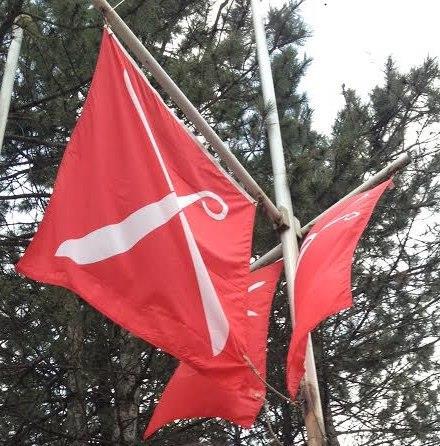 Image from Bishop Lamoureux, 22 August 2014
Image from Bishop Lamoureux, 22 August 2014
This "Scissors" flags is from "Wonderland" near Toronto. They have these scissors flags mixed among various country flags. The closest I found was the Zulfiqar Flags, a set of former flags from Morocco.
Bishop Lamoureux, 22 August 2014
No, that's not it; if it were the three flags would have been the same. The configuration of the flags suggests they are for something right in front or behind the pole. So, what attraction was next to it?
Peter Hans van den Muijzenberg, 23 August 2014
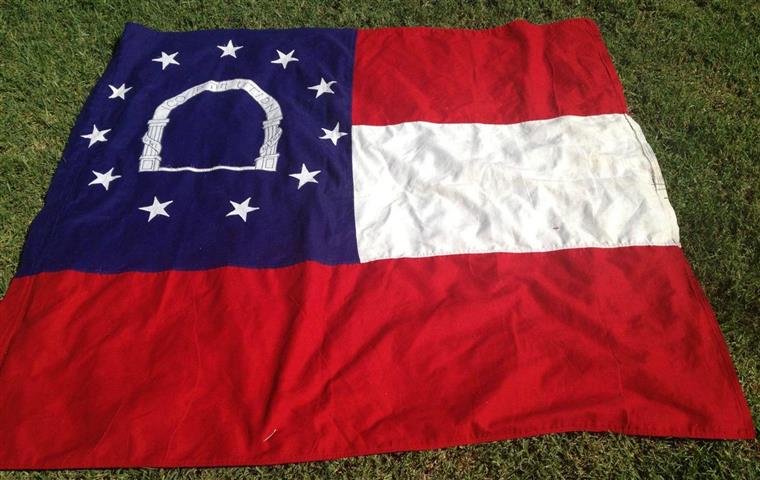
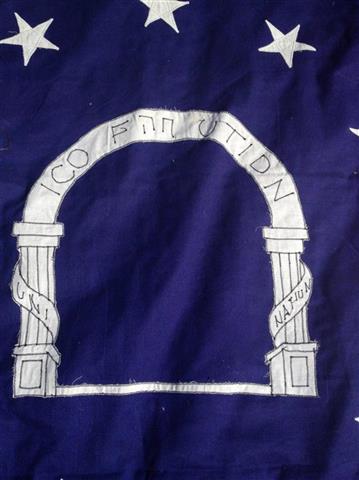
Images from Bishop Lamoureux, 22 August 2014
This flag was found it at a flea market in Pasadena. It is double-sided, and accommodates a flag pole. Anyone know what its from?
Bishop Lamoureux, 22 August 2014
Looks like an unfinished flag of Georgia.
Tomislav Todorovic, 22 August 2014
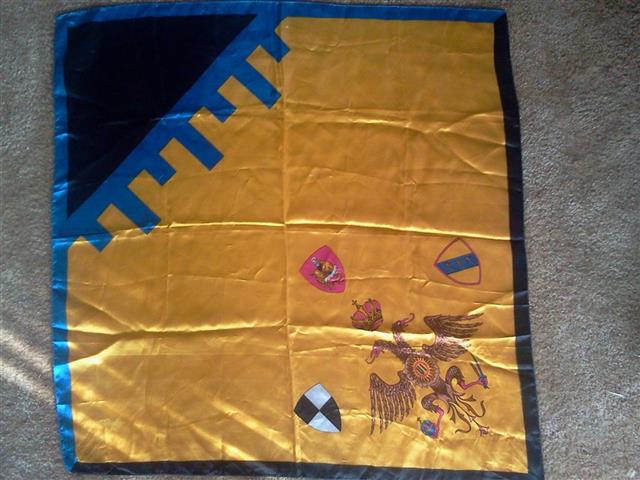

Images from Bishop Lamoureux, 22 August 2014
This flag was placed on Reddit, but the Vexillologists of Reddit could not identify it. The original poster stated "I got this flag from my dad several years ago and never knew where it came from. It looks like a crest, but it's in flag form. Does anyone know where this came from? And in the same vein can anyone tell me the correct orientation?"
Here is some of the speculation made about the flag on Reddit: 1. "The black and white quartered shield is the coat-of-arms of Zollern and the original arms of the House of Hohenzollern, eventually the royal family of Prussia and later of the German Empire." 2. "The two-headed eagle is a symbol of the Byzantine, Holy Roman, and Russian empires, but based on the Zollern arms and the Latin letters (not Greek or Russian). I think it's from the Holy Roman Empire." and 3. "The flag is probably the personal flag of some relatively low ranking German noble."
Can any of you comment on or identify this flag?
Bishop Lamoureux, 22 August 2014
If he doesn't know the orientation, what makes it a flag?
Peter Hans van den Muijzenberg, 23 August 2014
 Speculative image rotation by Pete Loeser, 23 August 2014
Speculative image rotation by Pete Loeser, 23 August 2014
It appears to be some sort of wall hanging, podium or decorative banner to me, but we've done coats-of-arms before. I'd say the orientation of the shields and double-headed eagle on the coat-of-arms would indicate the orientation might be diamond-like, or at least provide a strong clue. A size would be helpful.
Pete Loeser, 23 August 2014
It looks like Sienna aguilla to me. [The contrade are quarters of Sienna which compete in the li palio (a semi-annual bareback horse race). During the festivals - 2 July and 16 August - they use special throwing flags. Click here to see an image of a Sienna Aguilla palio throwing flag. - Ed.]
Peter Hans van den Muijzenberg, 23 August 2014
The crown is that of a Russian Tsar, but it might as well belong to Byzantine Empire (I don't know). And the arms above refer to St. Peter (look at the keys in base). It would be interesting to find out whether the flag is a replica or a silken original, and what the size of the flag is?
The ratio is similar to a military flag. The Zollern family gave princes to many European countries in the 19th and early 20th century, especially to Romania (but they had had a one-headed eagle), and Greece (they even now identify with the Byzantine Empire).
Klaus-Michael Schneider, 23 August 2014
It's a decorative flag of the contrada dell'Aquila in Siena. You can see the coats of arms on this picture. They are the three compagnie militari that form the contrada.
Fabio Brondi, 9 July 2016
Indeed, the palio and contrade are recurrent themes. I wrote on January 21, 2016 a message titled "Italian medieval flags - Quintana di Ascoli Piceno flags (and flag throwing related topics)" where you can see that all of these topics are related and we should piece them together into one section.
For instance, take UFE 15-22 (Hearst Castle Flags) where a set of Palio flags are seen. Since this is a practice more related to (but not exclusively) to Siena, most people refer to them as Palio di Siena. However, other Italian cities have such flag festivals as well. In fact, Siena and Lucca both feature the Libertas flag featured here on the Siena page and featured here
on the Lucca page.
Regarding the Alt Wiki, indeed, very nice images by the way (some real, some fictional, but worth taking a look).
Esteban Rivera, 17 July 2016
However, it's interesting to see someone mentioning a misinterpretation from a page, as it gives us the opportunity to delve into the problem and maybe improve our page style: What caused you to merge Klaus-Michael Schneider's contribution and mine above it into one, attributed to him? Is there a way to make the division clearer to you?
But, indeed, mine could be considered a tentative identification, as I only said it "looked like [that] to me." Fabio identified it more positively.
I think I disagree [about combining pages]. While general things could probably be said about such festivals in Italy [Please do, people!], il Palio is so rich with flags in my opinion that their specifics should be treated each on its own pages. As it's part of Sienna, those should be Sienna subpages.
Let's see. As I understand it, they have at least the following flags:
I also agree with Peter Hans on this one:
1. We should have a more elaborate section to deal with Palio flags (since it is a very widespread practice not only in the Tuscany region, but in other cities of the Italian Peninsula, to continue their medieval heritage).
2. Sienna, as well as Lucca, and other cities, should have their own subsections linking the Palio flags section (as they do indeed have them today).
I also agree that these are the sort of flags displayed in such events and they should be included into a section of itself. Also, did you get a chance to see my message(#207235) to the list? I point out details on how the actual games are rated and whoever gets the most flags win (also it includes the types of flags as well).
As to your comment on the flags at Hearst castle that is a very difficult thing to answer (but not impossible), since, as you mention, there are several types and I also wish we could have additional help to draw them all.
Indeed: I believe these [Libertas flags] are specimens of the same flag. Both Siena and Lucca are in the Tuscany Region and were part of the Republic of Siena (Repubblica di Siena), an independent State that lasted from 1125 until 1555/1559. Its motto is Libertas, and as the entry on the FOTW Siena section states: "Although the Republic of Siena is long gone, after being conquered by Florence during the Medici period, its flag is still flown, along with the City and People ones, from the main Gates, in special days, such as the week of the world famous Palio, as shown under. Thus it is not
presented as an historical flag." (no date on contribution, although I assume it was before 2006).
Bear in mind that we are currently under the games schedule! (they are held on July 2 and August 16. Also important to highlight, is the fact that in the "Tuscany - Historical Flags" we should include
before the entry on the Medici flag the "Republic's
Flag" on the Siena section since it predates the Medici conquest of such region.
Esteban Rivera, 18 July 2016
By the way, we seem to be looking at the reverse of the flag. with the eagle holding the orb dexter and the sword sinister. Compared to the
Shield of Casato di Sopra - quartered argent and sable - is also in reverse, but strangely that of Aldobrandino del Mancino - blue bend etc.
- is not. The details for San Pietro in Castelvecchio are too small to make them out.
Peter Hans van den Muijzenberg, 18 July 2016
Does this image work out for you? Also, please take a look at this other flag (source) at the Nobile Contrada dell'Aquila (official website).
Esteban Rivera, 18 July 2016
Yes, it does. That's what the flag looked like 1 July 2011, according to siena contrada dell'aquila, and still does according to Middeleeuws Siena nog springlevend. If my
theory is correct, then the design of the tourist flags would probably have had the shields somewhere. The banner, in 2012 looked like this, it seems, assuming that that's the right way to describe it.
As for the other flag I think that's a slightly older style. With all of the Internet available the problem isn't as much to find different styles, but more to correctly determine dates and purposes. In my recollection this one used to be quite prominent, though, suggesting that it may have been the last previous style. These websites don't contain as much flag information as I had hoped.
Anyway, I've now found the style we're looking for at "Paggi delle contrade storiche di Siena Aquila Squire Knight Chevalier" (image) and Siena - Il Palio - Contrada dell'aquila. The last one gives 1970 as the year, but seems to show a historical parade, suggesting it's actually a design from earlier times.
Peter Hans van den Muijzenberg, 18 July 2016
So should we start looking for designs by year? I know designs change from time to time, so do you think we can cover all of them?
At least I found the CoA evolution (from 1546 to 1888) at the Il Palio website (see image), and also a film archive of several contests of the different contrade. Another collection from Flags through Time (Immagini© Giuseppe Pirastru) would include:
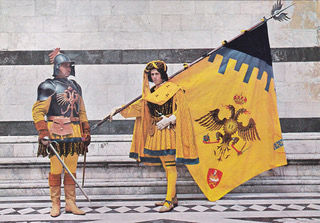 Image from Dave Martucci, 9 June 2019
Image from Dave Martucci, 9 June 2019
No doubt it is one of the variants of the flag of the Contrada Aquila of Sienna, used in the Palio. Each contrada in the city uses variants of its basic flag each year and these are then laid up in their respective museum. Attached is an old post card, probably 30 years old or so, showing the exact flag.
The post card is labeled Duce e Paggio Maggiore, Contrada Aquila (costumi da figurini di Emilio Griccioli), edizione autorizzata dal Magistrato delle Contrade, in esclusiva alla ditta Stefano Venturini-Siena.
Dave Martucci, 9 June 2019
I must have been sleeping in 2014. I missed this one. I have that identical postcard (indeed the complete set of cards of all 17 contrade), acquired when I was there in 1962. So, this variant was in circulation well over 50 years ago.
The Duce is the contrada contingent leader on the left. The Paggio Maggiore is the Major Page carrying the largest and most elaborate version of the contrada flag. Also in the parade contingent would be several flag throwers with slightly smaller flags of somewhat simpler design.
The UFE page had some puzzlement about the orientation of the flag. The postcard clarifies this puzzle perfectly. All the major pages carried their flag on the shoulder at a 45 degree angle, and their flags were/are designed for best viewing at that angle.
T.F. Mills, 9 June 2019

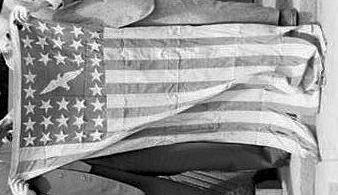
Image from Bishop Lamoureux, 22 August 2014
This picture was originally posted on Reddit. A Reddit editor posted this information about the picture. "The window and the pole say Oregon Historical Society. Oregon become a state in 1859, a few years before this flag was made. Based on the clothing the picture would be dated from about c1929. Thus the flag might have something to do with the 70th anniversary of Oregon's admission to the Union."
Another Reddit user surmised the following: "It has thirty four stars, so it would have to be an American/Union flag. The thirty fourth state to join the union was Kansas, so that might have some significance. The Union flag had thirty four stars from 1861-1863. This could have been a regimental flag."
Bishop Lamoureux, 22 August 2014
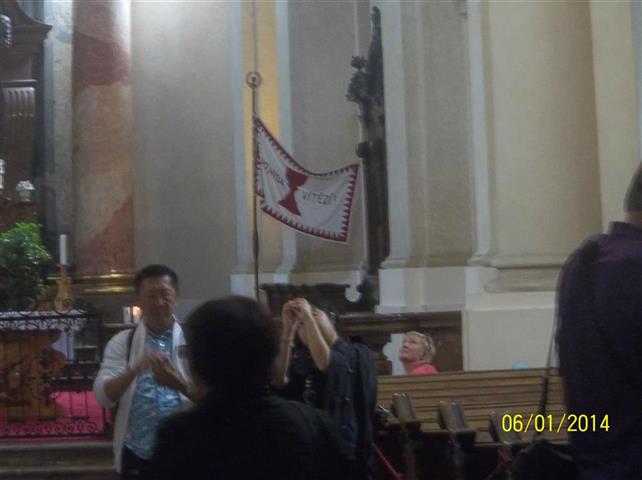

Images from Bishop Lamoureux, 22 August 2014
A description originally posted on Reddit: "I was in a Hussite Church in Prague and they had a pair of flags by the Alter. One was the flag of the Hussite Church in the Czech Republic, and the other was this one I have not been able to identify."
Bishop Lamoureux, 22 August 2014
The wording on either side of the red chalice on the flag is PRAVDA VITEZI, which is Slovenian for "THE KNIGHTS OF JUSTICE." There is a humanitarian aid organization called "The Sovereign Order of the Knights of Justice" that works with the United Nations. They provide aid to the poor and the sick, support schools in poor countries, and help children and the elderly people in Europe, Asia, Africa and America. The Sovereign Order of the Knights of Justice is divided into a number of so-called Grand Priories, Priories, Commanderies and Delegations. They are commanded by Grand Priors, Priors, Commanders and Delegates. One such division is the "Commandery of Czech Republic." I'm not sure they have a flag, but perhaps this is it.
Pete Loeser, 23 August 2014
Seems to be a good guess. As far as I know, the Hussites were divided into moderate Utraquists and radical Taborites (the latter were plundering Saxonia and parts of Brandenburg until they were defeated at Bernau). One of their religious targets, probably of both groups, was to celebrate the communion in both conformations (i.e. bread AND wine). The Catholics celebrated (and celebrate) it exclusively as bread. So a chalice might be an adequate symbol for Hussites.
Klaus-Michael Schneider, 23 August 2014
(Yes, I can see how Hussites would be a bit angry after the Catholics gave Jan Huss free passage, but burned him at the stake regardless.)
Considering that "pravda" means "truth", isn't it more likely to be the translation of "Veritas vincit", usually translated as "truth prevails"? It looks like the Hussite motto "Truth triumphs over all", is used in that shortened form by Czechia itself. Combined with the symbol of the chalice, that would suggest a Czechian Hussite flag.
Peter Hans van den Muijzenberg, 24 August 2014
The use of a chalice on a flag in Prague isn't surprising, the earliest evidence indicates that a "gonfaion" was used for a symbol of the Old Town of Prague as early as 1419, and a Hussite chalice was used on the Prague Banner in c1477. To quote my earlier self: "It was during the Hussite Wars the City of Prague was attacked by the "Crusaders" and mercenary forces, and the city militia fought back bravely under this Prague banner." It is not unexpected to find it also used as a symbol on this modern flag, whatever it may be.
Pete Loeser, 24 August 2014
This is a typical Hussite flag and is used by the Czechoslovak Hussite Church. So, I am curious about the other flag you saw.
Pravda vítezí is indeed Czech for victoria vincit (truth prevails), it was the motto of Hus and his followers, the official motto of the first Czechoslovak Republic, and is still depicted on the standard of the President of the Czech Republic.
Jeroen van Leeuwen, 26 January 2015
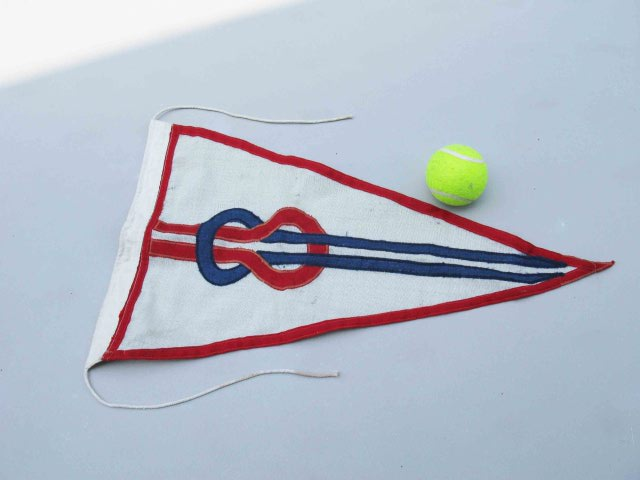 Image from Albert S. Kirsch, 30 June 2014
Image from Albert S. Kirsch, 30 June 2014
[This enquiry is a bit out of order, sorry I was asleep at the wheel - Ed.]
Does anyone recognize this pennant? It would appear to be a yacht club burgee; It was found with WW2 Japanese and German items.
Albert S. Kirsch, 30 June 2014
A tennis ball being something like 6.7 cm, this pennant would be approximately 25 cm. high. It might be slightly more because the apparent size of the pennant changes with the camera angle, while the ball's size doesn't.
As an aside: Don't connect your ropes that way, unless all four ends are secured. This is an open connection and it will over time move towards loose ends. That's why the well-known flag knot has two of the lines crossed, so there'll be tension to keep it in place.
It seems somewhat familiar, but I don't dare to say I've seen it before. I especially don't for all the flag knots I recall.
Peter Hans van den Muijzenberg, 24 August 2014
This flag has been positively identified as that of the Vale de Prazeres e Mata da Rainha Commune in Portugal.


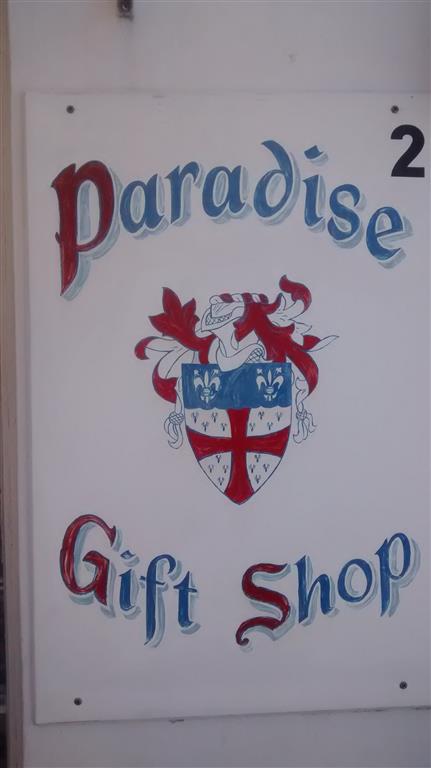
Images from Bishop Lamoureux, 4 September 2014
The original poster, Imnimo, said "I saw this flag flying outside a gift shop in St. George's, Bermuda. It's a bit hard to see because it's wrapped around the pole, but it looks like it's the same as the coat of arms painted on the side of the building. After a bunch of Googling, I haven´t been able to find it anywhere - is this just a random family crest in flag form, or is there more too this flag? As far as I can tell, it isn't the flag of any Bermuda municipality."
Bishop Lamoureux, 4 September 2014
 Image from Bishop Lamoureux, 4 September 2014
Image from Bishop Lamoureux, 4 September 2014
This was the description from wessideride: "Took this photo at a African refugee rally in Israel, could anyone identify the flag for me and give me some information?" Some reddit users posted these theories regarding the origins of the flag.
Bishop Lamoureux, 4 September 2014
I do not know what the flag represents, however I note that it is the Ogaden National Liberation Front flag (red, blue, green stripes) with an additional black stripe and the star enlarged and re-centred.
The ONLF (a separatist group in Eastern Ethiopia) was established in 1984 and diaspora communities are currently commemorating the 30th anniversary of the founding of ONLF on 30 August 1984. The current supporters of Ogaden liberation continue to use the ONLF flag.
The photo was taken at a World Refugee Day event on Tel Aviv in June 2013 for World Refugee Day. It appears to have been a rally of 200 Eritreans who were commemorating the martyrs in Eritrea's struggle for independence.
Ralph Kelly, 5 September 2014
Perhaps it is a new Somali Bantu flag?
Jaume Ollé, 6 September 2014
Could this be the new ONLF flag mentioned on our page "Ogaden (Ethiopia)", but not shown?
Pete Loeser, 6 September 2014
 Image from Ralph Kelly, 9 September 2014
Image from Ralph Kelly, 9 September 2014
I looked at several Ogaden websites and they are all still using the original Ogaden National Liberation Flag as the de-facto flag for Ogaden (called by some Ogadeniya). Tony Burton of Flags Australia recently helped some Ogaden people in Sydney to obtain hand-wavers of this flag for their 30th anniversary commemoration. Chrystian Kretowiicz on 5 Dec 2010 included this illustration of the ONLF flag. It has the ONLF emblem on a white over red bi-coloured flag. As you can see - it is not our UFE.
Ralph Kelly, 9 September 2014
In 2009, the OLF was divided in two factions: the OLF-QC (Oromo Liberation Front - Qaama Ceehumsa) and the OLF-SG (Oromo Liberation Front - Shanee Gumii), both using the same flag. In 2010, one of the factions created the Revolutionary Democratic Oromo Liberation Front (RDOLF). The white over red could be the unknown flag of RDOLF that in 7 March 2011, joined the ULFO. It is known that the OLF didn't change its flags and the main faction is now using the R-V-R flag.
The ULFO was created in April 2010 by three movements:
1) The Front for Independent Democratic Oromiyaa (FIDO) / R-V-R flag with central emblem
2) The United Oromo People's Liberation Front (UOPLF) / N-R-W flag with central emblem
3) The Council of Oromiyaa People's Liberation Front (COPLF) - Gumii adda bilisimmaa ummata / N-R-W flag
The flag of ULFO is the N-R-W version. The RDOLF flag is not known to me. The image from Christyan could be, in fact, a partial image lacking the black upper stripe, rather than a accurate image of the RDOLF flag. Many of the Oromo groups use the N-R-W colors with their own emblem, or variants of this arrangement. An extensive article about flags of Africa, Gambella, Harar, Oromia and Ogadenia will be published in Flag Report 72 that will be distributed in October 2014.
Jaume Ollé, 9 September 2014
This photograph was also used on this article on the Jewish Journal website, which also included a different photograph showing the same flag. There was no mention of "wessideride" as a source in the article.
Peter Hans van den Muijzenberg, 10 April 2015
[This flag was re-reported as being seen in Paris, see UFE15-6. - Ed.]
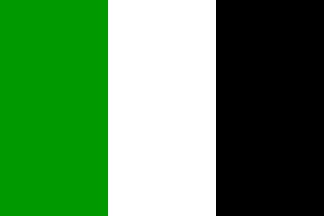 Image by António Martins, 28 September 2023
Image by António Martins, 28 September 2023
On the Italian Ebay one can buy a collector´s card with a strange design for a flag of Botswana (Beciuania), namely a green-white-black vertical triband. Is this purely fictitious or an early design?
M. Schmöger, 6 September 2014
This still unidentified tricolor reported by M. Schmöger. Nothing like it in [bw_hist.html] could it be just an actual hoax? Eitherway, even if so, it was published in a widely (?) circulated medium, this Italian-language collectible card set from around the 1960s. I tried to dig more info but I only found a much better image than that on eBay at [ https://i.redd.it/possible-flag-of-the-bechuanaland-protectorate-v0-ihsu6vj9kqb81.jpg ] [ https://archive.ph/kBQmI ], illustrating a 2022.01 post in the subreddit r/vexillology [ https://www.reddit.com/r/vexillology/comments/s45ife/possible_flag_of_the_bechuanaland_protectorate/ ], where user 2005KaijuFan implies they had access to the source, a set of Italian flag stickers , but offers no url nor more details (no title, publisher, etc. sad!).
Italian Vexillology is mature and sophisticated; this source is likely well known any more info?
António Martins, 28 September 2023
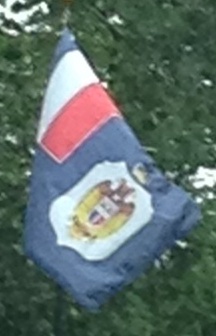 Image from Tom Cseh, 9 September 2014
Image from Tom Cseh, 9 September 2014
Any idea who this particular flag with what appears to be the French tricolor in the upper hoist might belong to?
Tom Cseh, 9 September 2014
I have never seen it before, but if the photo was taken in Mexico, it might date back to the occupation of this country by the French army (along with British, Spanish and even Belgian troops, but only the French stayed there for a while) in the XIXth Century. I don't think the French army had enough time to establish a local administration.
Corentin Chamboredon, 10 September 2014
Way outside my area, but could this flag have anything to do with the period in which the Emperor Maximilian ruled the country with French support? Is three years long enough to establish an administration which would require a flag.
Christopher Southworth, 10 September 2014
The flag does not have the coat-of-arms used during the Second Mexican Empire of Maximilian I, but the shield on this flag has a double-headed eagle and may have a connection with Maximilian's Austrian or Holy Roman ancestors, perhaps Austrian troops sent in support of the French claim? Notice the similarities to the Austro-Hungarian coat-of-arms. Examples at Austro-Hungarian Empire: Imperial Standards and Austro-Hungarian Empire: Military Flags.
Pete Loeser, 10 September 2014